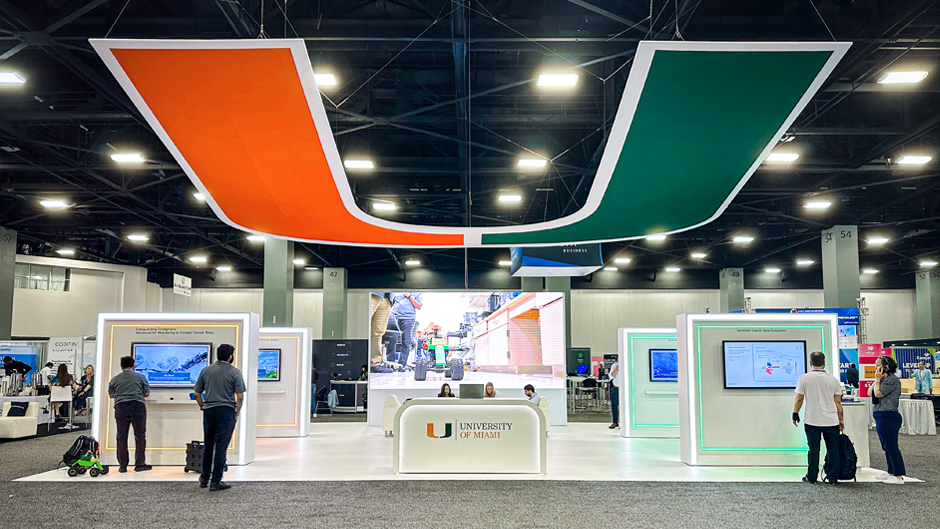University of Miami researchers and students will display tech innovations during the eMerge Americas 2024 conference and expo this week.
The two-day event at the Miami Beach Convention Center also marks the 10th year of the conference. Visit Booth 525 to learn more about the innovations happening at the University.
Attendees will hear from various keynote speakers, including a UHealth – University of Miami Health System panel, “High-Touch is High-Tech in 21st Century Patient Experience,” and a Main Stage panel discussion, “Climate Challenges, Health Tech Solutions: Miami on the Front Lines,” moderated by University President Julio Frenk.
Other discussions will feature Grammy Award-winning artist and entrepreneur Armando Christian Perez, also known as Pitbull, and founder of Girls Who Code, Reshma Saujani.
Access the full eMerge 2024 agenda and check back throughout the event for updates from the Miami Beach Convention Center.
View a host of videos and photos from the event.
Friday, April 19
How tech can mitigate the impacts of climate change on health care
Powerful hurricanes and the storm surge they generate have left thousands of residents in coastal communities homeless. Meanwhile, searing heat waves have sent home electric bills soaring while straining power grids across the nation.
But how has climate change, along with the worsening weather it has spawned, affected health care? And how have medical research and technology combined in South Florida to mitigate the health impacts of the climate crisis?
That was the topic of a Friday eMerge panel moderated by University of Miami President Julio Frenk, a former minister of health for Mexico.
Held on the eMerge main stage inside the Miami Beach Convention Center, “Climate Challenges, Health Tech Solutions: Miami on the Front Lines” featured leading experts from the health, tech, and climate sectors discussing how cutting-edge research and tools are allowing health systems to adapt to a changing climate.
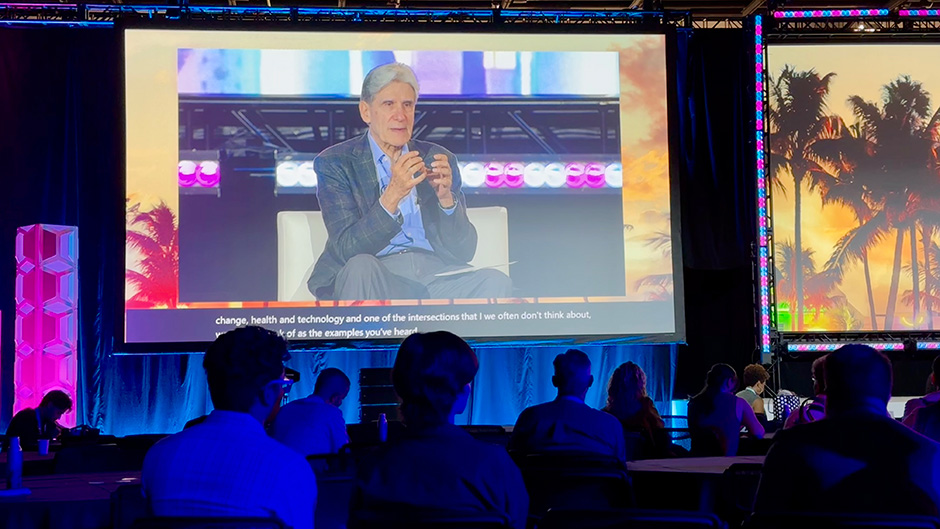
“Clearly, Miami is ground zero for the effects of climate change,” said Frenk, who went on to detail the many ways in which tropical cyclones, drought, and other extreme weather events impact health, from causing the loss of life and serious injuries to contributing to outbreaks of diseases when public services and power are interrupted.
Sea level rise, he noted, threatens the supply of safe drinking water, while heat imperils the elderly population and those with no access to air conditioning.
Climate change is also contributing to the spread of vector-borne diseases, Frenk pointed out. “Now, mosquitoes and other vectors are present at latitudes where they were not present before, so we’re seeing a resurgence of malaria and the emergence of new vector-borne diseases like Zika,” he said.
But researchers and clinicians at Sylvester Comprehensive Cancer Center are taking the fight to climate change, studying the density of tree cover in Miami and delving deeper into the effects of sun exposure, the center’s director, Dr. Stephen Nimer, pointed out during the panel.
“We have 10 different sites across South Florida where we deliver health care. So, if there was a hurricane, probably two-thirds of them would be able to continue to deliver care,” Nimer said.
The Oscar de la Renta Endowed Chair in Cancer Research and executive dean for research at the Miller School of Medicine, Nimer also noted the school’s medical mobile vans that deliver health care in communities across Miami, telling the audience that the fleet of vehicles could be expanded in the event of a disruptive climate event such as a hurricane that would make it difficult for patients to reach a medical facility.
College of Engineering dean Pratim Biswas told the audience how he and a team of researchers are developing wearable sensors that send a signal if someone is being exposed to an infectious agent. He also noted the college’s new Miami Engineering Autonomous Mobility Initiative, which is developing technology for electric vertical takeoff and landing aircraft that could transport patients to medical facilities, bypassing gridlock traffic.
“The challenges we face with climate-related issues have put pressure on us to step up and develop technologies that help,” said Biswas, adding that students at the college are trained to be problem-solvers.
But it will take more than one entity to help lessen the impacts of climate change on health care, said David Rhew, global chief medical officer for Microsoft. “It’s a collaboration that has to occur between government agencies, including public health, including hospitals and health systems, and then community-based organizations,” he said. “And a lot of this is around mobilizing, getting people to understand more about what they need to do with communications.”
Rhew noted the creation of chatbots to help facilitate better communication in times of crises. “The chatbots have now become much better. It used to be purely an algorithm that we would just simply allow you to provide information,” he said. “Now, we can upload entire documents and have a person have a conversation with the chatbot. And it could explain things in their language at their grade level with empathy. So, these are the types of technologies that allow us to be able to provide that direct level of communication.”
— Robert C. Jones Jr.
Miller School of Medicine at eMerge
The Miller School of Medicine played a prominent role in the global technology conference and expo, including co-sponsoring the Health Technology Innovation Hub with Jackson Health System.
MILBox: The Future of Personal Medicine
Health care has the potential to be even more tailored to each patient with the introduction of the MILBox. The project, an innovative creation from the Media and Innovation Lab at the University of Miami Miller School of Medicine, will allow the user to explore their biological algorithm.
“This is where we can make health care more personalized, enabling us to capture a wide variety of data points for each individual,” said Azizi Seixas, interim chair of the Department of Informatics and Health Data Science and associate professor in the Department of Psychology and Behavioral Sciences. “Now, we can capture patients’ health on the go, enabling us to take a 360-degree perspective and provide effective treatments.”
Inside the MILBox, users will find devices to capture data, such as a blood pressure monitor, an ActiGraph to measure sleep and wake cycles, a smart scale, an air quality device and a mobile phone to transmit data to the cloud securely.
This data collection creates a digital twin for their doctor, allowing providers quick and accurate diagnosis and treatment plans.
— Joseph Garcia
Virtual Reality Integrated into Health Care Construction
When participants in the UHealth SoLé Mia topping off ceremony tried on headsets at the construction site, they saw the building’s completed operating room. The technology, used by the construction company Robins and Morton, enables users to visualize and share virtual mockups of the spaces planned for development.
Virtual mockups are faster and cheaper than physical mockups, and the end users of these spaces, including surgeons, doctors and nurses, actively provide feedback on the design.
During onsite sessions, these same end users help determine design, offering insights on equipment placement, lighting, outlets and overall flow and functionality. This collaborative process ensures that the space is optimized to enhance patient care.
— Joseph Garcia
A VR experience at eMerge
Growing up in her native Jamaica, University of Miami senior Kumani Riley always had a keen interest in mangroves, realizing that the tropical plants not only protect shorelines from damaging storm and hurricane winds but also help prevent erosion and maintain water quality.
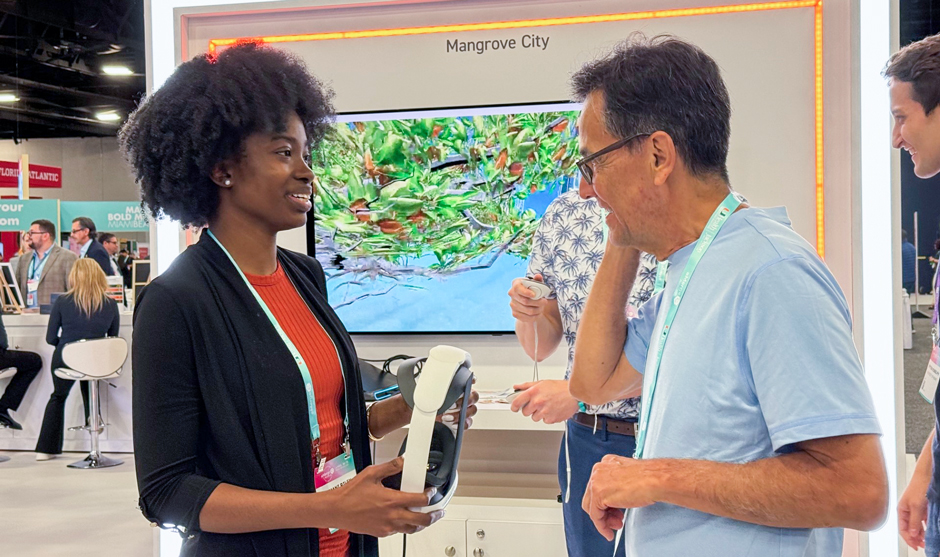
So, when she got the chance to work as one of the designers of Mangrove City—a virtual reality experience designed to teach middle school students the crucial role mangrove forests play in protecting coastal communities and mitigating climate change—she couldn’t have been happier.
“Climate change, sea level rise, sustainability—those topics are near and dear to my heart,” Riley, a computer science and interactive media major said Friday at eMerge, where she demonstrated the Mangrove City VR headset at the University’s multi-station booth. “Working on this project allowed me to combine my interests in the environment with my love of technology.”
— Robert C. Jones Jr.
A monster truck modified to save lives
If it looks like a miniature remote-control monster truck, that’s because it once was.
The rover modified by University of Miami graduate students Chitvan Killawala and Umer Bakali to carry a special chemical-detecting sensor was purchased at a local hobby shop.
“We removed the original chassis and designed and built a new one, outfitting it with our special sensor,” Killawala, a doctoral student in biomedical engineering, said Friday at the eMerge Americas conference, where his research project on safeguarding firefighters from dangerous chemicals present at structural fires was featured.
“We also had to make a few other special adaptations, such as ensuring that the rover could navigate rough terrain, which is often found at fire scenes,” he said while maneuvering the rover over his foot to demonstrate his point.
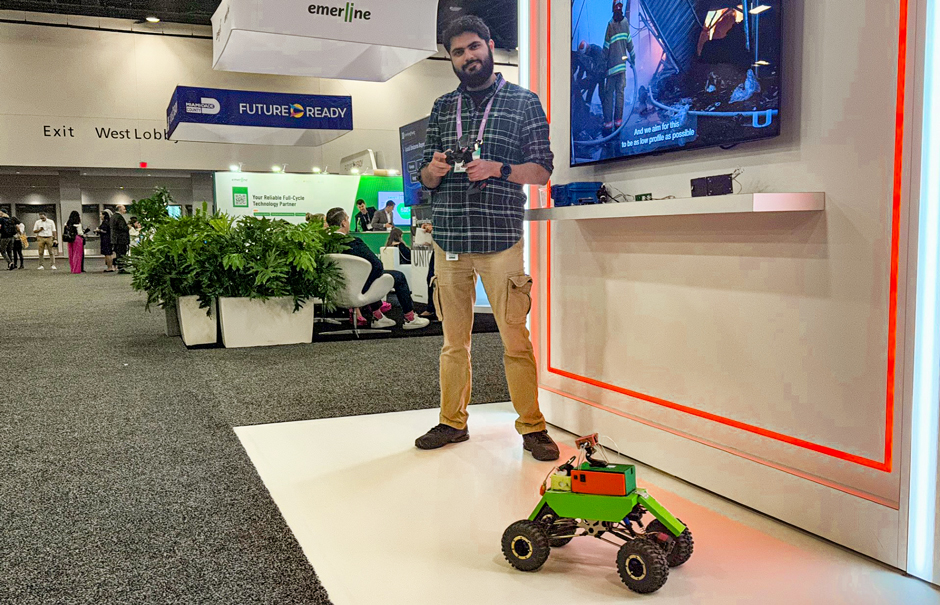
During controlled live burns at fire-training facilities in Miami-Dade, Broward, Palm Beach, and Pinellas counties, Killawala and Bakali drove their rover into the warm zones of structural fires. The sensor, attached to the top of the rover, provided a chemical readout in just a few seconds, showing elevated levels of polycyclic aromatic hydrocarbons, or PAHs, a known carcinogen to humans.
“It was the evidence we needed to prove to firefighters that they would be wise to wear protective gear in the warm zone as a precaution,” Killawala said.
The two students are modifying their sensor to make it more effective and are planning further testing at fire academies located in other Florida cities.
For Bakali, a doctoral candidate in biochemistry and molecular biology at the Miller School of Medicine, working on the sensor is just one aspect of his work with the Sylvester Comprehensive Cancer Center’s Firefighter Cancer Initiative (FCI). Launched in 2015 through a state of Florida appropriation, FCI documents the excess burden of cancer among Florida firefighters to identify novel, evidence-based methods for reducing risk.
As part of his research with FCI, Bakali helped develop silicone-based wristbands, using them as monitoring devices to test the rates at which firefighters might be exposed to dangerous chemicals.
“The wristbands can be used as passive sampling tools to capture firefighters’ occupational exposures,” Bakali explained. “The beauty of the protocol is its simplicity for the firefighter: We pre-clean the wristbands and place them in glass vials to distribute to firefighters to wear, and since they’re so lightweight and durable, they can be used in almost any type of fire situation. The wristbands are then returned to us in those same vials, and then whatever compounds were captured on them are extracted and analyzed.”
But the sensor will always be a special project for Bakali.
“Unlike the projects with the passive sampling wristbands, which really can only be used to show exposures after they have happened, the sensors have the significant benefit of giving firefighters an early warning against toxic compounds,” Bakali said. “If sensors like these were put into use in fire departments nationwide, what we effectively would accomplish is give first responders the capacity to mitigate exposures on their own. Putting that kind of power in their hands is a major step toward reducing the burden of cancer in the fire service.”
He graduates this summer and has already accepted a position as a chemist with the U.S. Army. “I’ll be analyzing and countering chemical weapon threats, ultimately reducing the likelihood of soldiers’ exposures,” he said. “Some of my favorite experiences throughout my Ph.D. have involved research out in the field, and I am excited to have more opportunities to do that moving forward. And it’s a good bet that I’ll end up crossing paths with military firefighters, who have their own unique set of exposures.”
— Robert C. Jones Jr.
Robots and lung cancer
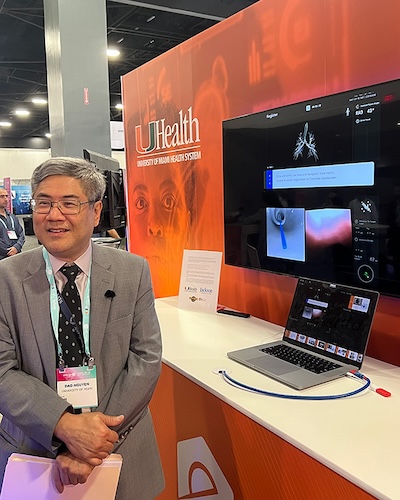 The earlier lung cancer is treated, the better the chance of survival. While CT scans help, physicians at Sylvester Comprehensive Cancer Center use robotic bronchoscopy and robotic surgery to local small tumors in the narrow airways of the lungs.
The earlier lung cancer is treated, the better the chance of survival. While CT scans help, physicians at Sylvester Comprehensive Cancer Center use robotic bronchoscopy and robotic surgery to local small tumors in the narrow airways of the lungs.
“This technology will help with early detection and intervention in mitigating mortality rates associated with lung cancer,” said Dr. Dao Nguyen, professor of surgery and section chief of thoracic surgery at the Miller School of Medicine as well as a member of Sylvester’s Thoracic Surgical Oncology team. “At Sylvester, we are affirming the efficacy of their systematic utilization of cutting-edge technology in medical practice.”
Detection starts with robotic navigation in the lungs to help surgeons access deep lung tissue and sample lesions. A dye spotlights the tumor’s location, should surgeons need to remove it.
The approach utilizes advanced equipment to enhance diagnostic accuracy and streamline the transition to surgical intervention, ultimately improving patient outcomes.
— Joseph Garcia
A fast and furious start on Day 2 of eMerge
eMerge attendees who felt the need for speed made a brief pit stop at the Healthtech Innovation Hub powered by UHealth and Jackson Health System.
There, they got an up-close and personal look at a real Formula 1 race car similar to the ones that will burn up the track at the 2024 Miami Grand Prix, which will take place over 57 laps at the Miami International Autodrome on May 5.
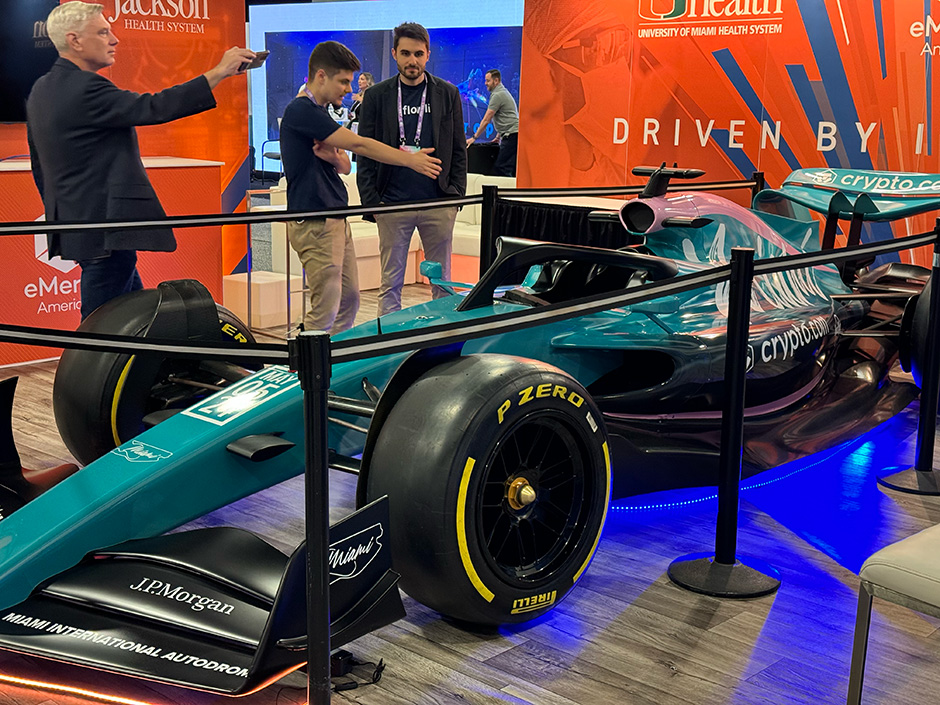
JMH is the official medical provider for the upcoming F1 Miami race, and on Friday, many of the attendees who stopped by the Healthtech Hub got the barcode on their eMerge badge scanned for a chance to win two tickets to the race.
“These cars look fast even when they’re standing still,” said Jibril Barbee, a senior software engineer for the American College of Financial Services, who entered for a chance to win passes to the race.
— Robert C. Jones Jr.
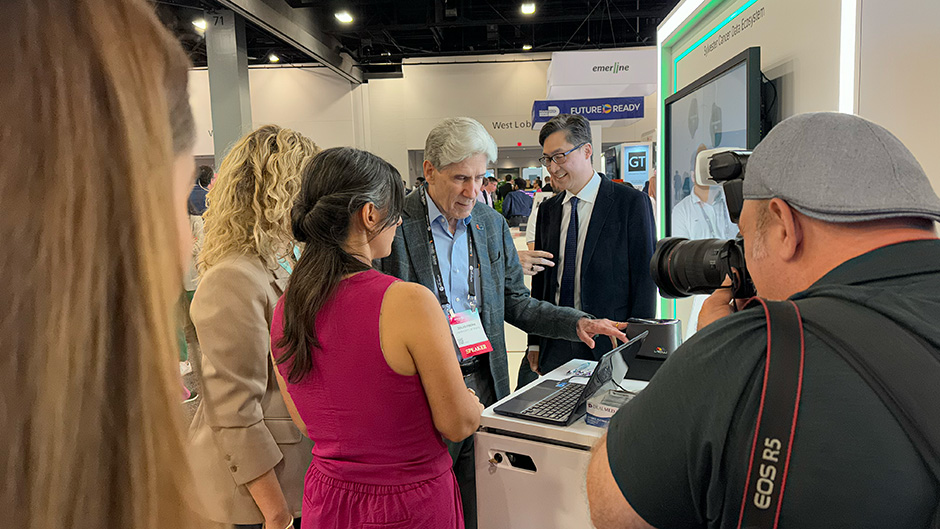
Innovation and health care
University of Miami President Julio Frenk arrives at eMerge in advance of a panel he will moderate that explores how medical research and emerging technologies are converging in South Florida to drive innovation and address the health impacts of climate change.
His first stop at the University’s booth was the Sylvester Cancer Data Ecosystem station, which highlighted for eMerge attendees a comprehensive digital repository that will integrate patient-generated lifestyle data with genomic, imaging, clinical records and sociodemographic factors sourced from electronic health records.
— Robert C. Jones Jr.
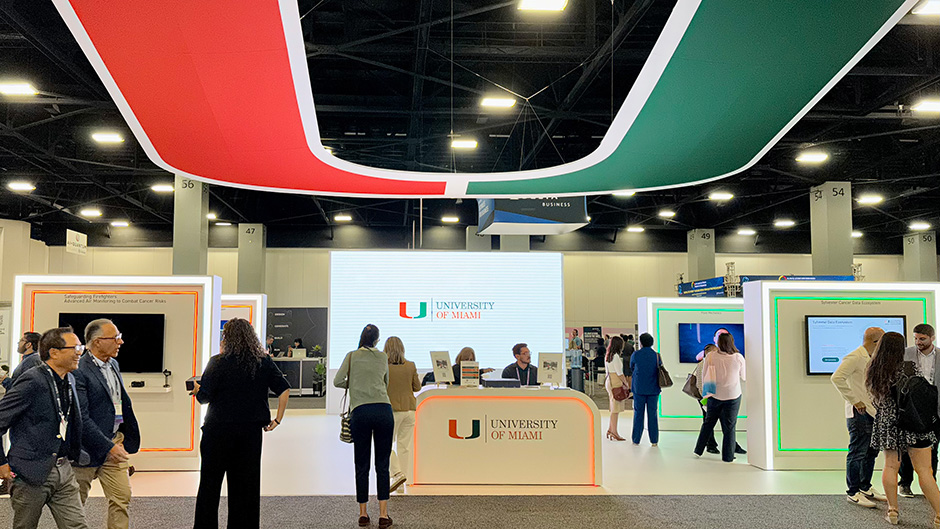
Day two underway
The University of Miami’s booth at eMerge Americas 2024 buzzed with activity early Friday, as day 2 of the technology conference got underway at the Miami Beach Convention Center. Scientists and students are on hand to provide demonstrations to visitors on innovative research ranging from a modified rover equipped with a special sensor capable of detecting dangerous chemicals at structural fires to a high-tech 3D printer that fabricates highly advanced materials.
— Robert C. Jones Jr.
View this post on Instagram
Thursday, April 18
Alumni success in the virtual reality space
Many University of Miami alumni could be found visiting the booths at eMerge Thursday, while some others were hosting their own.
Arianne Hirsch, an alumna who graduated in 2022, was hosting her own booth for a virtual reality app called Levitate that she cofounded with Joel Hollander, lecturer of art history. Levitate is a digital well-being application that combines modern psychology and authentic mindfulness practices, while also transporting users to a serene location, such as a garden.
“We want people to have a sense of peace, well-being, and calm in an accessible way,” said Hirsch, who spent a year developing the app after earning degrees in interactive media and studio art.
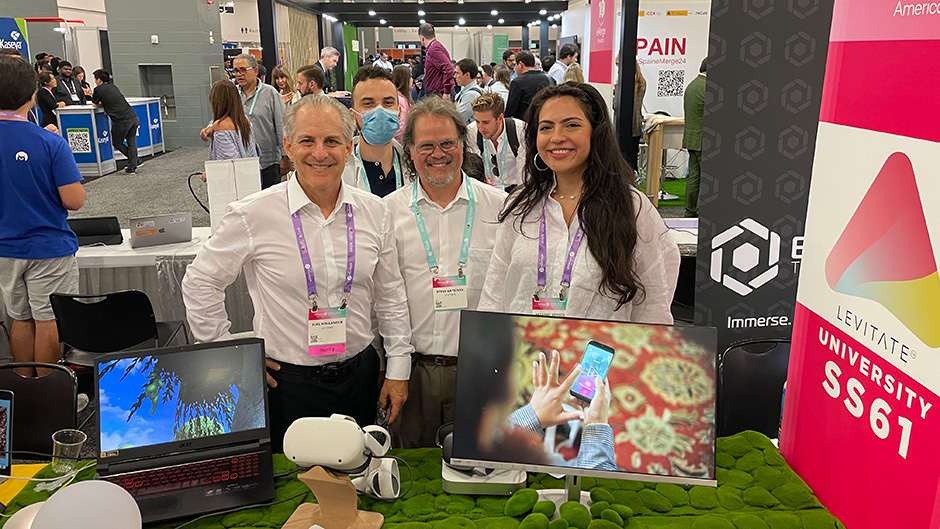
Levitate is now available on the MetaQuest app lab, so it currently requires a Quest headset, but Hirsch is working to create a version that people can use on the Apple Vision Pro, as well as screens very soon. So far, they have 5,400 users, and have noticed that some people use it daily.
“I’ve been meeting a lot of interesting people at eMerge and hopefully some will be interested in continuing our conversations about Levitate,” she said.
Hirsch, who also serves as CEO of Levitate, is one of three University alumni teams that will participate in the Startup Showcase at eMerge Americas on Friday morning.
— Janette Neuwahl Tannen
Using augmented reality to decrease pre-operation anxiety
When patients are gearing up for an operation, anxiety and fear of the unknown can be pervasive.
The Sports Medicine Institute at UHealth—University of Miami Health System has developed an augmented reality (AR) experience to make the pre-op period easier.
When patients put on the AR headset, they see what their operating room looks like and receive a script, narrated by their surgeon, of what to expect during surgery. Incorporating AR into the pre-op process proved successful in a Sports Medicine Institute randomized trial that compared a set of patients who prepared for their procedures using AR to those given paper handouts.
“Patients with this AR experience had decreased preoperative anxiety by about 10 percent,” said Michael Rossi, M.D., an orthopaedic fellow at UHealth/Jackson. “Our institute is piloting this technology, which was developed within medicine. We want to apply this experience outside of orthopaedics while looking at patient anxiety and satisfaction levels.”
— Joseph Garcia
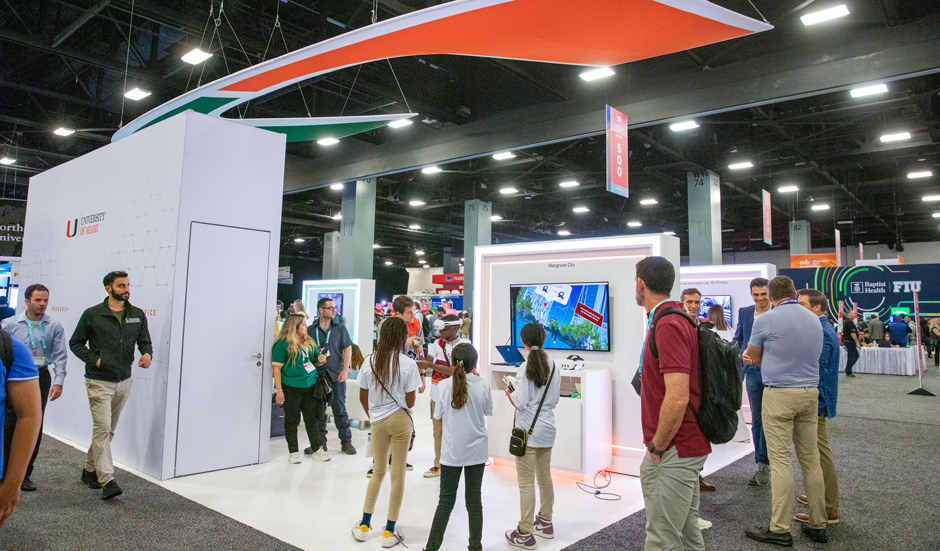
Mangrove City and more at University of Miami booth
The eMerge Americas conference opened Thursday to thousands of tech-focused entrepreneurs, researchers, and consumers.
And the University of Miami booth, positioned toward the front of the expo floor, was attracting a flood of conference attendees, who lined up to try some Per’La coffee, founded by alumni Chris Nolte and Paul Massard. Others got a chance to try some of The Salty’s green and orange doughnuts, another business founded by University alumni, while perusing the seven innovation displays.
Students from Horace Mann Middle School enjoyed testing out the Mangrove City app developed through the UMverse, and especially enjoyed the ability to paddle through the water, as they donned the MetaQuest headsets to take a ride on paddleboards through a fictional city to learn about the importance of mangroves and the animals that live around them.
Maoro Soladade, an entrepreneurship student from the Link School of Business in São Paolo, Brazil, and his classmate Maria Antonia Gama, also enjoyed the ability to paddle through Mangrove City, assisted by Bryson Rudolph, an extended reality software engineer for the Frost Institute of Data Science and Computing and the UMverse.
“It was very cool, and we are very focused on revolutionary technology like this,” said Gama.
Microsoft principal software engineer for mixed reality Denise Mendez was also talking with Kim Grinfeder, professor of interactive media and UMverse director and Tom Merrick, assistant director of the UMverse at the display for Mangrove City.
“More than any other University in South Florida, the University of Miami is becoming a spatial computing campus, and is integrating immersive technology as part of their classes,” said Mendez. “To build for immersive tech platforms, you need a different mindset that is often not taught today, where you combine software engineers, audio engineers or experts, and animators and writers, but UM is doing that through its UMverse.”
— Janette Neuwahl Tannen
At the University of Miami booth, many eMerge attendees stopped to learn about the rover created to protect firefighters from harmful chemicals in the air.
Developed in the lab of Sylvia Daunert, professor and chair of the Department of Biochemistry and Molecular Biology at the Miller School of Medicine, doctoral students Umer Bakali and Chitvan Killawalla, helped to conceptualize and create these sensors, designed to measure volatile organic compounds in the air. The rover is used to help place the sensors into warm zones, or areas where firefighters take off their gear and protective masks, but may still be exposed to toxins in the air, Bakali said.
Just across the University’s exhibit space, leaders from the Miller School’s Department of Radiology were showcasing a new AI tool that is helping them to speed up the diagnosis process, particularly for patients who have troubling medical issues. By partnering with Tel Aviv-based aidoc, UHealth radiologists are now able to prioritize or “triage” cases that look like a patient may have an urgent, critical medical condition because the technology brings these images to the doctor’s attention first.
Since it was implemented last summer, Dr. Alexander McKinney, professor and chair of radiology, said the tool has helped to lower the amount of time it takes radiologists to diagnose medical images by 20 percent to 50 percent.
“Sometimes patients walk into our UHealth facilities and they are asymptomatic, but when we do a scan, we find something in a chest CT that shows they need to go to the emergency room, and that’s when we can really make a difference, because it truly alerts us to something troubling,” said Dr. Thiago Braga, an assistant professor of clinical radiology who was speaking to eMerge visitors Thursday. “We can take care of these patients more quickly and can treat them right away.”
Guillermo "Willy" Prado, interim executive vice president for academic affairs and provost of the University, spent part of the morning visiting the booth at eMerge, as well as some of the others at the conference.
“I’ve been so impressed by the work our graduate students are doing to protect firefighters from harmful chemicals, and the work of our radiologists to identify diseases and conditions early on using technology for preventive care, as well as our groundbreaking hurricane modeling, and immersive technology applications,” said Prado. “This is a proud moment for all of us who work at the U, because our students, faculty and staff can showcase the innovative work they are doing.”
— Janette Neuwahl Tannen
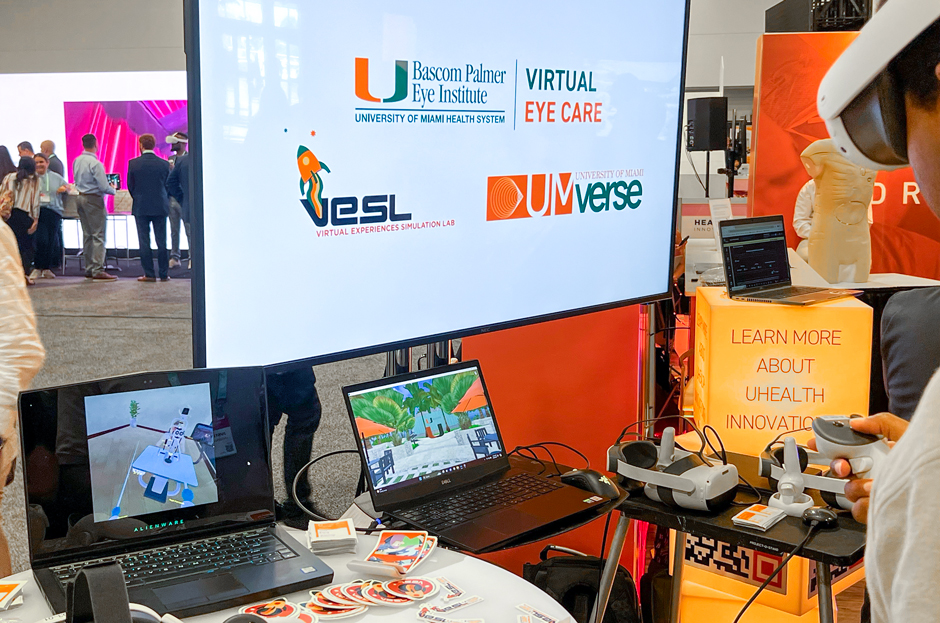
Bascom Palmer takes VR to the next level
Technology meets accessibility in the latest virtual reality (VR) experience from Bascom Palmer Eye Institute (BPEI). Students and ophthalmology residents are taking part in a week-long, virtual reality course that uses VR technology to teach them how to operate a slit lamp, the microscope with solar-folded light optometrists use to examine patients.
Slit lamps rate low in accessibility because they’re usually in a room that can hold at most three people. Bascom’s transformative idea two years ago was to create a simulator that grants broader access to the lamp. Users don a headset and are transported front and center to the virtual microscope, which they operate using remote controls. The VR software also comes with a number of eye case studies.
“Our booth is all about showcasing the University of Miami's commitment to expanding virtual reality education,” said Joao Eduardo Llano Ribeiro, programmer for the University of Miami Frost Institute of Data Science and Computing. “We see this technology as a way to leverage skill transfer and give students access to things they would otherwise find difficult to approach or access.”
A VR guide to the Jose Berrocal Auditorium within Bascom Palmer accompanies the course. The guide was engineered by creating a digital twin of the original building followed by a Light Detection and Ranging (LiDAR) scan of the auditorium replicated in virtual reality.
Future Bascom Palmer implementations involve more VR courses and partnering with doctors to build out a virtual medical campus.
— Joseph Garcia
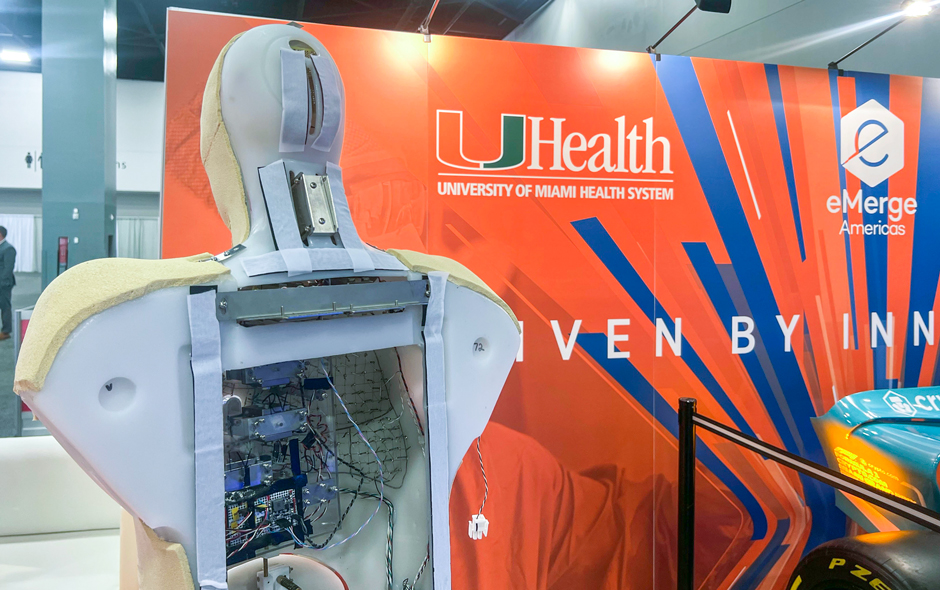
Harvey drives the future of medical education
The name Harvey is well-known when it comes to simulation in medical education. Since 1968, the famed manikin created at the Gordon Center for Simulation and Innovation has been a beacon of innovation.
Harvey is effective because it’s built to mirror the real patient experience. Harvey is available in different skin tones and has a textured feel similar to human skin. Its mechanical composition simulates the functions of a real person and is regulated by a computer that sends out pulses of accurate body sounds while providing fluid blood motion throughout the heart and lungs.
“Harvey provides students and trainees an accurate patient experience,” said Adrian Gonzalez, a Harvey development specialist. “Through our classes with Harvey, we are increasing our fidelity to education through simulation.”
— Joseph Garcia
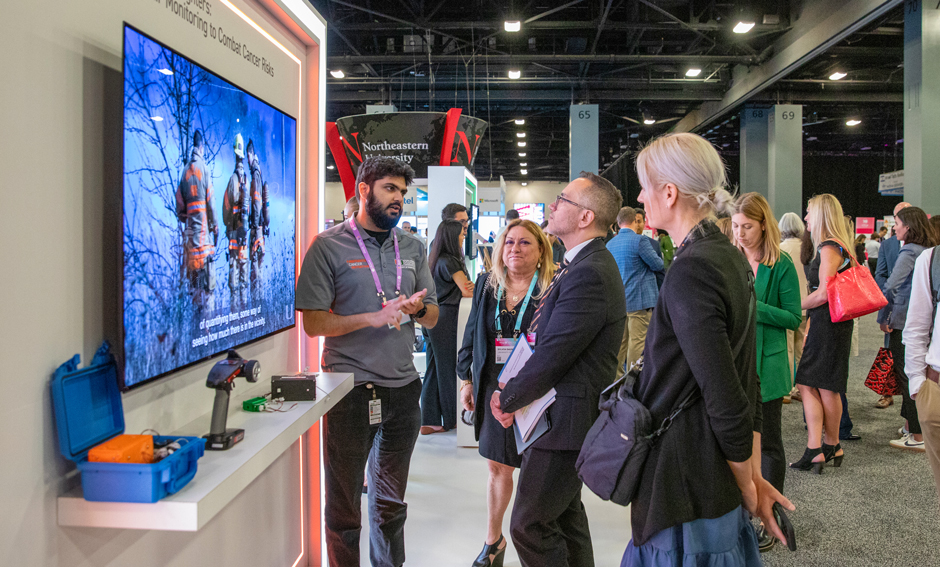
Viewing firefighter safety sensor
Prior to his appearance on the LaunchPad Stage, Guillermo "Willy" Prado, interim executive vice president for academic affairs and provost, visited the University's booth to get a first-hand look at the research innovation happening across campus.
— Megan Ondrizek
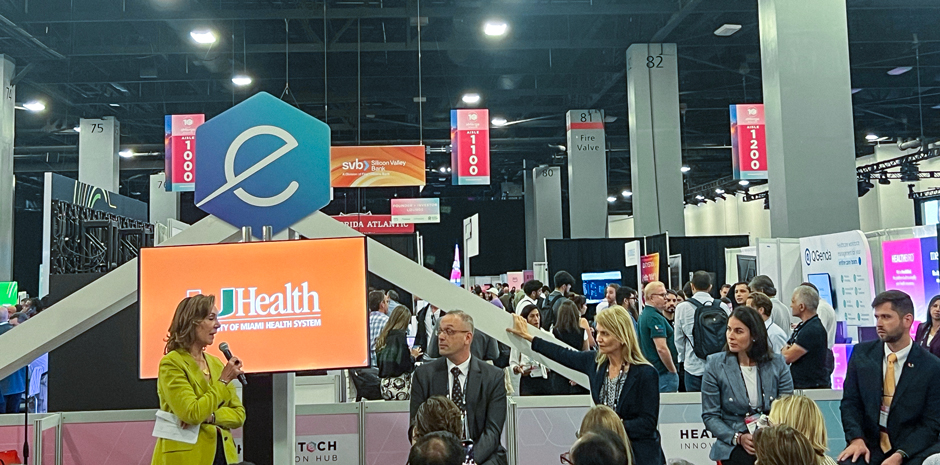
UHealth innovation forges a VIP patient experience
UHealth—University of Miami Health System patients have already noticed how technology is improving their experience.
Some of the key players behind that experience led a “Technology and Patient Experience” discussion panel at eMerge Americas, including:
- David Reis, the University of Miami’s senior vice president and chief information and digital officer
- Dr. Tanira Ferreira, chief medical officer of University of Miami Hospital and Clinics
- Brianne Neuburger Simon, UHealth vice president of operations
- James Lindgren, UHealth executive director for health system optimization
UHealth has incorporated a litany of tools in its software ecosystem, including e-check-in, MyUHealth Chart and facial recognition, while maintaining patient privacy and a catered experience.
The technology UHealth wields is easy to use and optional for patients, meaning they have the tools they need to make informed decisions about their technology preferences. Physicians also benefit, as a good number of patients have enrolled in a derivation of MyChart when seen at other health care organizations. Those patient histories can be accessed by UHealth physicians and contribute to current care.
UHealth currently has 90 artificial intelligence (AI) projects in the works, all of which use spatial technology around the patient without being tied to an app.
— Joseph Garcia
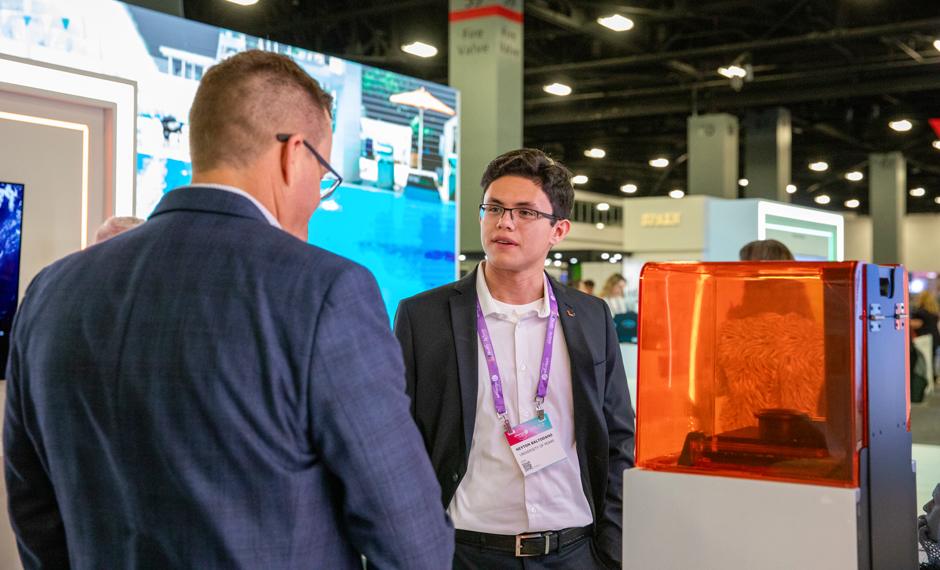
3D printing in action
Morning traffic may have delayed the arrival of some attendees, but the researchers exhibiting their work at the University of Miami booth during the first day of eMerge Americas were ready to go.
The College of Engineering had on display items produced at its Advanced Materials Innovation Lab, with professor of practice Charles "Chip" Tomonto and student Neyton Baltodano at the booth discussing their ongoing research. The researchers are developing a new method to create more durable carbon-reinforced materials, improving the strength and conductivity of carbon fibers.
After learning about the innovation, many walked away with a souvenir from their visit: a 3D-printed white keychain showcasing the split-U.
— Megan Ondrizek
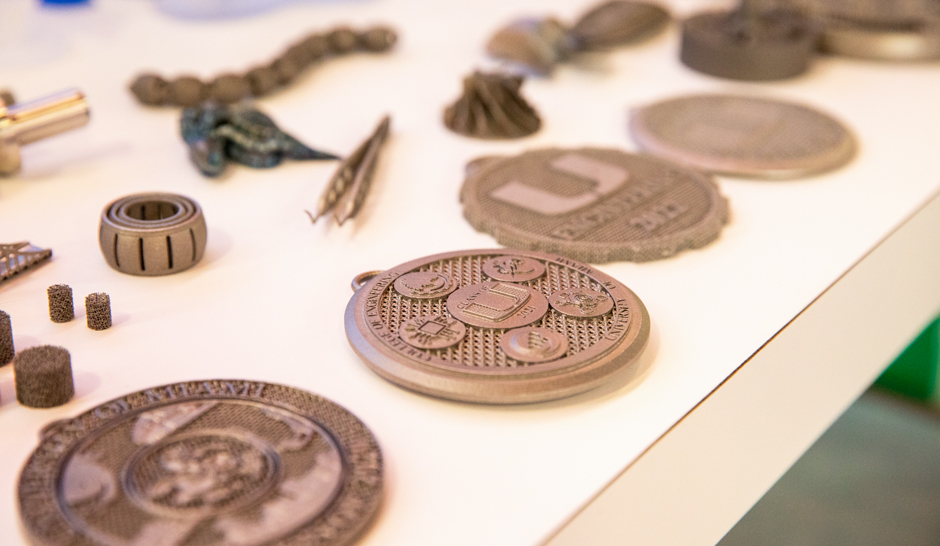
Wednesday, April 17
With the start of the conference just hours away, we wanted to share a couple of posts on two of the projects that will be seen at the University of Miami booth.
Safeguarding firefighters
The dangers firefighters face while battling infernos are not always as obvious as searing heat and collapsing roofs. They also face the risk of being exposed to polycyclic aromatic hydrocarbons, or PAHs, a known carcinogen to humans.
University of Miami graduate students Chitvan Killawala and Umer Bakali, however, have developed a special sensor that helps warn firefighters when dangerous levels of the chemicals are present.
“There’s very little solid evidence on the levels of PAHs that firefighters are exposed to, particularly inside the warm zone of an active fire scene where team staging activities occur and where firefighters aren’t suited up in personal protective gear. So, our sensors help fill a void,” said Killawala, a doctoral student in biomedical engineering.
PAHs, which result from burning coal, oil, gas, wood, garbage, and tobacco, can bind to or form small particles in the air.
To test for the dangerous class of chemicals, Killawala and Bakali used small commercially available sensors that were designed to measure vinyl chloride and other chemicals, tweaking the parameters of the sensors to test for PAHs. “The PAHs interact with the sensor and cause a voltage drop, basically a dip in the way that the sensor reads. And that gives us a readout that we can compare to a baseline when there are no PAHs present,” explained Bakali, a doctoral candidate in biochemistry and molecular biology at the Miller School of Medicine.
To test the effectiveness of their sensor, the two graduate students purchased a miniature remote-controlled monster truck from a hobby store, modified its exterior, and mounted their sensor on its top.
Then, during controlled live burns at fire-training facilities in Miami-Dade, Broward, Palm Beach, and Pinellas counties, they drove their modified mobile rover into the warm zones of structural fires. The sensors, which render a readout in just a few seconds, recorded elevated levels of PAHs, providing evidence that firefighters would be wise to don protective gear in the warm zone as a precaution.
The two are modifying their sensor to make it more effective and are planning further testing at fire academies located in other Florida cities.
— Robert C. Jones Jr.
On display: Hurricane Analysis and Forecast System
Scientists at the University of Miami Cooperative Institute for Marine and Atmospheric Studies (CIMAS) worked with researchers at the National Oceanic and Atmospheric Administration (NOAA) who led the development of a new, more accurate hurricane model that will be used this season by the National Hurricane Center to alert residents about emerging tropical cyclones. The Hurricane Analysis and Forecasting System (HAFS), developed with NOAA’s Atlantic Oceanographic and Meteorological Laboratory, can foster results that are up to 15 percent more accurate than earlier forecasting models for determining the track of a storm, as well as its intensity.
“We always want more accurate hurricane forecasts and longer lead times to warn people to make preparations, put up shutters, or evacuate their homes,” said William Ramstrom, senior software engineer at CIMAS, who has been working to develop HAFS for the past five years. “This model gives us the opportunity to have more accurate track locations, while also figuring out which storms are more likely to intensify as they approach land, and therefore are a bigger threat.”
NOAA ran HAFS alongside existing models as an experiment in 2022 for the National Hurricane Center—a division of the National Weather Service. Based on strong performance, it was made one of NOAA’s official hurricane forecast models in summer 2023. Ramstrom said the model’s strength is its higher resolution, made possible by new supercomputers that are able to forecast steering currents and humidity over a large area with points spaced 3.6 miles apart. Within a hurricane, the model can zoom in to forecast data every 1.25 miles. This was one element that Ramstrom’s team focused on as part of the HAFS.
“It’s like when you increase the number of pixels on a camera, the pictures become sharper and look better—we are doing the same with a hurricane forecast,” he said. “This will allow us to narrow the zones we think are under threat for a hurricane and may give forecasters the opportunity to move from a five-day outlook to a seven-day outlook, to give longer lead times on warnings.”
Ramstrom and his team look forward to seeing their work utilized and hope it will be able to offer better information to South Florida and all Americans this summer. In the future, they plan to extend the model to collect data on tropical cyclones across the globe.
“The public will be seeing these results every day during hurricane season and it’s a very direct path from the coding work that we do, to seeing that we have a reliable and accurate model being discussed on television and in social media by forecasters,” Ramstrom added. “That’s really exciting work that is making an impact, especially here in Miami where we’re under the threat of hurricanes and everyone is well aware of it.”
—Janette Neuwahl Tannen
